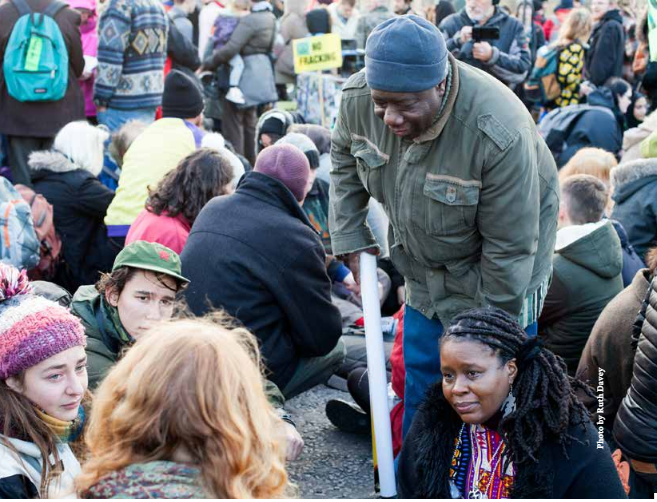Direct Action or Occupations
Depending on the size and duration of the protest and the level of police presence, these assemblies could potentially be a quick decision making assembly or a more in depth, multi layered assembly.
A quick decision making People's Assembly
‘the police have given us these options, what should we do?’.
In a situation where an extremely rapid decision is required there is no need to dispense with the assembly format. Many assemblies have been held on the streets to facilitate a decision making process with the police acting to clear the protest away. In all known cases, the assemblies have been able to finish their deliberation and in many cases, where they have been in the streets, they have been seen to be incredibly empowering and drawn and held the attention of passing members of the public. The process itself need only be simple, but the format should be the same - set people in groups, give them a question, give them a time limit to discuss it, gather the results and then act on the results. With clear communication, or even using the mic-check process, these kinds of assemblies can be run, from start to finish, in around 20 minutes. During a direct action protest, police liaison should be able to negotiate that time for a decision to be made on whether to stay or go, for instance. ).
An in-depth decision making People’s Assembly
At a protest or occupation, wherein there is no immediate time pressure, the People’s Assembly process can be used to make decisions on what target to pick for an action or whether a non-vegan locally sourced option should be included on the menu, for example.
Where time allows, these broader assemblies can include the Testify element, which is an opportunity for participants to speak to the whole group about their feelings on the subject. This element can help to shape the discussion and helps to focus the assembly on a number of shared concerns. It also encourages other participants, who may not be willing to express their feelings to the whole group, to be more likely to express their feelings in the small group discussion, in turn helping to get a broader perception of the sentiments of the whole group in the final phase.
The rest of the process would follow that standard People’s Assembly format, with small group discussions and feedback to decide on a response to the question.
A full People's Assembly
These can form part of the outreach during an action or occupation, and can be designed to include members of the public, or include invitations to people from organisations or institutions that are being targeted or affected by the impacts of the target of the protest to come and participate in the process.
The subjects for discussion can relate directly to the target of the action, or can be more broad and inclusive such as ‘how can we support each other in our communities in the face of climate breakdown?’ or ‘how can we help each other to face the grief that awareness brings?’
When people are invited to attend an assembly at a protest or occupation from outside of the movement they should be made aware of the potential consequence of that, but also be reassured that attendance at an assembly alone is very unlikely to result in any form of prosecution.
Summary
People’s Assemblies provide us with a process by which to move and act with immense flexibility as a large group during times of action or occupation. They allow for immediate changes and decisions to be made on the spot that enable us to act and react with speed and flexibility, whilst still being able to make those decisions collectively, and in large numbers.
They are the root of a lot of our internal meeting structures and decision making processes, having their own roots in protest movements and movements against the spread of harmful civilised perceptions of control for hundreds of years at least and provide a snapshot of the sort of community based democracy processes we will need to rely on in the future.

